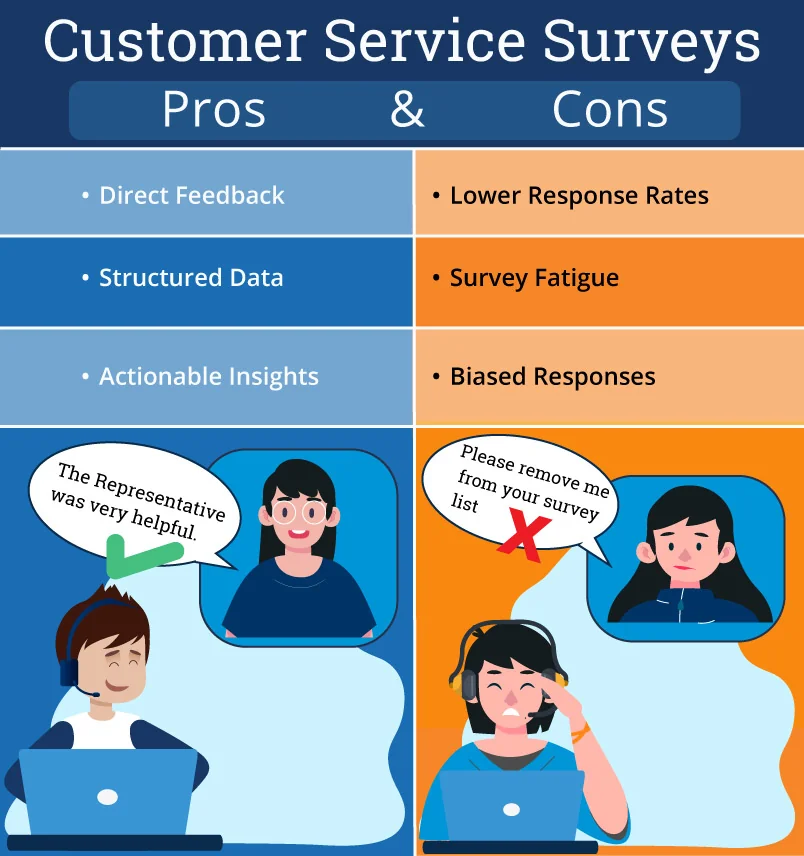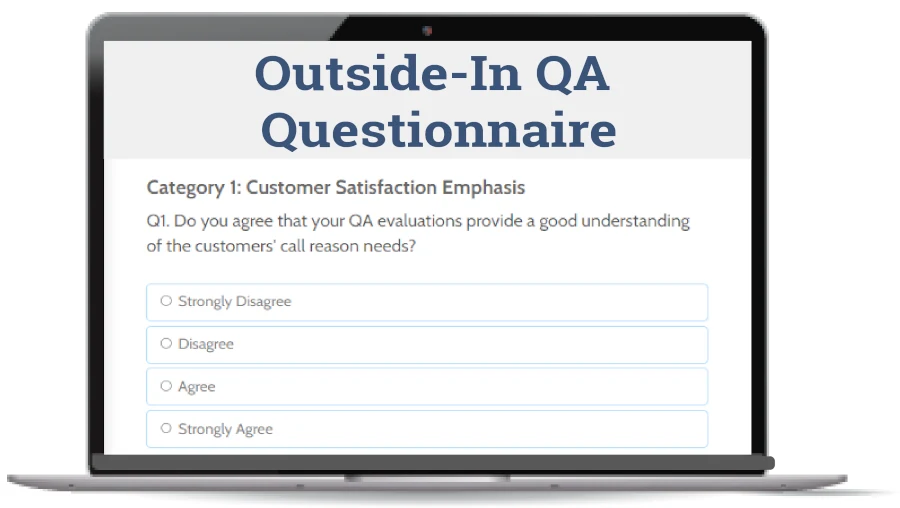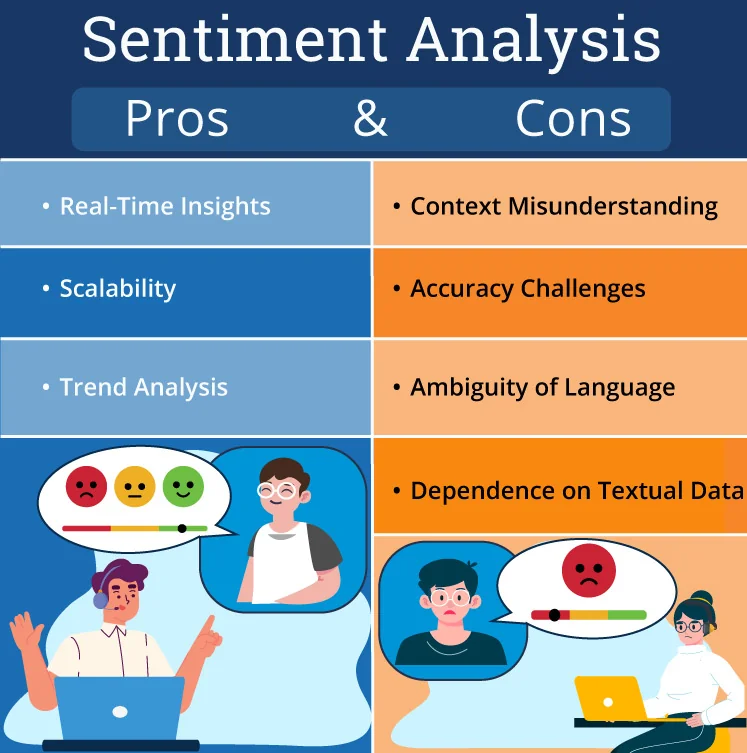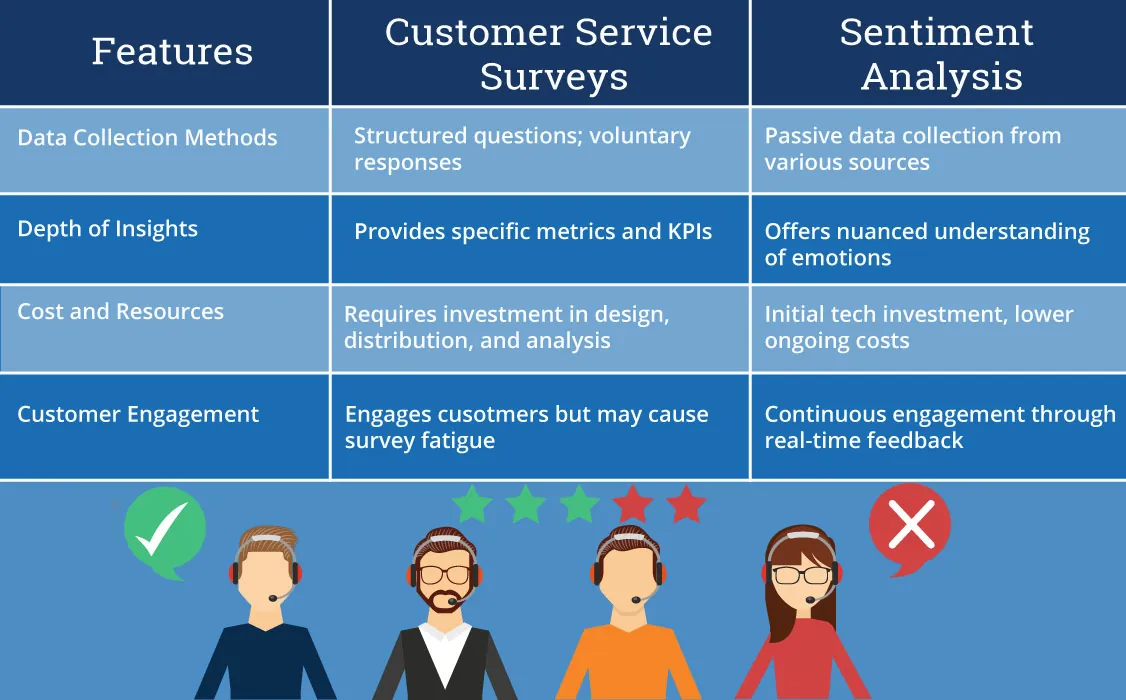Traditional customer service surveys have long been the go-to method for gathering feedback, helping companies measure satisfaction and identify areas for improvement.
However, as consumer expectations evolve and technology advances, the effectiveness of these surveys is being called into question. Enter sentiment analysis—a powerful tool leveraging natural language processing and machine learning to decode customer emotions from various data sources, including social media, chat logs, and even voice calls.
This blog explores the potential of sentiment analysis to revolutionize the way businesses gather feedback. Will it replace traditional customer service surveys, or will the two coexist in a complementary relationship?
Understanding this shift is vital for call center professionals, as it can impact how customer interactions are managed and how insights are derived. Join us as we delve into the nuances of both approaches, examining their benefits, challenges, and the future of customer feedback.
What are Customer Service Surveys?
Have you ever been asked to stay on the line after the call has ended to complete a customer service survey? Have you been asked questions such as, "On a scale of one to five, with one being very unsatisfied and five being very satisfied, overall, how satisfied are you with your experience?" If so, you have taken part in a customer service survey.
Customer service surveys have long served as a cornerstone of customer feedback strategies, providing businesses with structured insights into customer satisfaction and service quality. These surveys typically come in various formats, including Net Promoter Score (NPS), Customer Satisfaction Score (CSat), and Customer Effort Score (CES), each designed to measure specific aspects of the customer experience.
At their core, customer service surveys aim to collect quantitative and qualitative data directly from customers about their experiences. By soliciting feedback after interactions—whether through phone calls, chat, or email—companies can gauge how well they meet customer expectations and identify improvement areas.
What are the Common Types of Surveys?
- Net Promoter Score (NPS): Measures customer loyalty by asking how likely customers are to recommend a company to others on a scale of 0 to 10.
- Customer Satisfaction Score (CSat): Captures immediate satisfaction levels with a specific interaction, often using a simple question like "How satisfied were you with your experience today?"
Customer Effort Score (CES): Assesses how easy or difficult it was for customers to resolve their issues, focusing on the effort required during the service interaction.
What are the Pros and Cons of Customer Service Surveys?

Customer service surveys offer several advantages:
- Direct Feedback: They provide businesses with firsthand accounts of customer experiences, helping to capture specific pain points and successes.
- Structured Data: Surveys generate quantifiable metrics that can be easily analyzed, allowing for straightforward comparisons over time and across different teams or departments.
- Actionable Insights: The structured nature of surveys enables organizations to identify trends and make informed decisions to enhance customer service.
Despite their benefits, customer service surveys also come with notable limitations:
- Low Response Rates: Many customers may overlook or ignore surveys, leading to skewed data that may not accurately represent the broader customer base.
- Survey Fatigue: Frequent requests for feedback can lead to customer disengagement, reducing the likelihood of responses and diminishing the quality of insights gathered.
- Biased Responses: Respondents may have strong emotions—either positive or negative—that do not accurately reflect the overall customer experience, leading to unbalanced feedback.
Does Your Call Center Use an Outside-In QA Approach to Deliver Great Csat?

What is Sentiment Analysis?
Sentiment analysis is a powerful tool that leverages advanced technologies, such as natural language processing (NLP) and machine learning, to interpret and quantify emotions expressed in text. By analyzing customer communications, sentiment analysis aims to understand customer feelings and opinions better.
At its core, sentiment analysis involves automated identifying and extracting subjective information from text. This process categorizes sentiments as positive, negative, or neutral, enabling businesses to gauge customer emotions at scale. The primary purpose is to derive actionable insights to inform strategies for improving customer service and overall experience.
How Does Sentiment Analysis Work?
Sentiment analysis relies on algorithms that analyze language patterns and context. Key components include:
- Natural Language Processing (NLP): This technology helps machines understand, interpret, and manipulate human language. It breaks down text into understandable units, enabling the identification of sentiment.
- Machine Learning: By training on vast datasets, machine learning models can improve their accuracy over time, recognizing nuances in language, such as sarcasm or context-specific meanings.
What are the Pros and Cons of Sentiment Analysis?

Sentiment analysis offers several advantages for businesses:
- Real-Time Insights: Companies can monitor customer emotions as they unfold, allowing immediate response to issues.
- Scalability: It can quickly process vast amounts of unstructured data, providing insights that traditional surveys may miss.
- Trend Analysis: By tracking sentiment over time, businesses can identify patterns, assess the impact of changes, and refine their strategies accordingly.
Despite its many advantages, sentiment analysis has notable limitations:
- Context Misunderstanding: Sentiment analysis tools can struggle with context, leading to misinterpretations of sarcasm, irony, or cultural nuances.
- Accuracy Challenges: The effectiveness of sentiment analysis heavily depends on the quality of the underlying algorithms and training data. Poorly trained models may yield inaccurate results, affecting decision-making.
- Ambiguity of Language: Human language is complex and often ambiguous. Sentiments can be expressed in nuanced ways that automated systems may fail to capture fully.
- Dependence on Textual Data: Sentiment analysis typically relies on written data, which may not always represent the entirety of a customer's experience. For instance, non-verbal cues in voice interactions can convey sentiments that text alone cannot capture.
Will Sentiment Analysis Replace Customer Service Surveys?
The debate over whether sentiment analysis will replace traditional customer service surveys is gaining traction as businesses seek more effective ways to understand customer feedback.
Both methods offer distinct advantages and limitations, and their potential roles in customer service may not be mutually exclusive.
Comparing the Two Approaches
Data Collection Methods
Customer service surveys utilize structured questions that require voluntary responses from customers. These surveys can be delivered through various channels, such as email, phone, or online platforms, and often focus on specific aspects of the customer experience.
In contrast, sentiment analysis collects data passively from various sources, including social media, chat logs, and reviews. This method allows businesses to analyze large datasets without requiring explicit customer input, capturing their feelings in real time.
Depth of Insights
Surveys provide specific metrics and key performance indicators (KPIs) that help businesses gauge customer satisfaction and loyalty. While useful, they can sometimes offer a limited perspective, focusing mainly on quantifiable data.
On the other hand, sentiment analysis offers a more nuanced understanding of customer feelings, capturing the subtleties of emotions expressed in language. This approach can reveal underlying sentiments and trends that traditional surveys may overlook.
Cost and Resources
Creating effective surveys involves costs related to design, distribution, and analysis. Businesses must invest time and resources to ensure surveys are well-crafted and effectively reach their target audience.
While sentiment analysis may require an initial investment in technology and software, it generally involves lower ongoing costs than traditional surveys. Once set up, it enables continuous monitoring with less manual effort.
Customer Engagement
While surveys can engage customers by soliciting their feedback, they also risk causing survey fatigue. Frequent requests for responses may lead to lower participation rates and less reliable data.
Sentiment analysis fosters continuous engagement through ongoing dialogue, allowing businesses to capture customer sentiment as it evolves. This real-time feedback mechanism can enhance customer relationships and provide immediate insights into customer satisfaction.

The Case for Hybrid Models
Rather than viewing sentiment analysis and customer service surveys as competing methods, businesses may benefit from a hybrid approach that combines both. By integrating sentiment analysis with traditional surveys, companies can gain a comprehensive understanding of customer sentiment.
Surveys can provide structured feedback on specific interactions, while sentiment analysis captures ongoing emotional responses throughout the customer journey. This combination allows for richer insights, enabling organizations to address issues and enhance customer experiences proactively.
For instance, a company might use a survey to rate customers' satisfaction with the customer service they received on a scale from 1 to 10. Then, sentiment analysis could analyze customer comments or social media posts related to customer service, revealing emotions and sentiments that the numerical rating alone does not convey.
Sentiment Arc Analysis vs. Traditional Sentiment Analysis
An emerging form of sentiment analysis called sentiment arc analysis offers a more dynamic approach than traditional sentiment analysis.
While traditional sentiment analysis categorizes sentiments as positive, negative, or neutral based on specific keywords, sentiment arc analysis tracks emotional fluctuations over time, capturing the entire customer journey.
The sentiment arc analysis method allows businesses to identify critical moments influencing customer sentiment, revealing patterns and trends that can inform proactive strategies.
By understanding how sentiment evolves—such as a customer's initial enthusiasm turning into frustration due to a service issue—organizations can address concerns more effectively and enhance the overall customer experience.
Customer emotions can shift rapidly, and sentiment arc analysis provides deeper insights, complementing traditional methods and paving the way for a more comprehensive understanding of customer feedback.
As businesses explore these advanced techniques, integrating sentiment arc analysis with traditional surveys could offer a robust framework for understanding and improving customer service.
